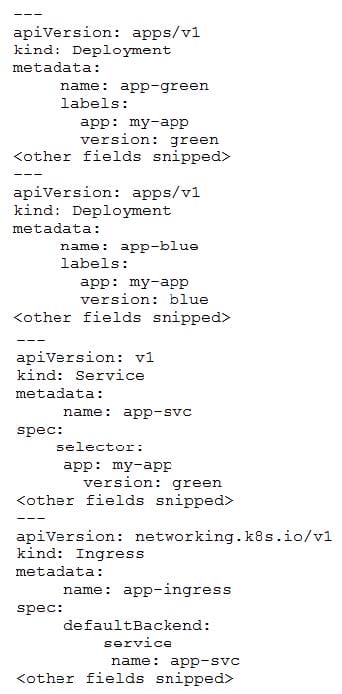Exam Details
Exam Code
:PROFESSIONAL-CLOUD-DEVOPS-ENGINEERExam Name
:Professional Cloud DevOps EngineerCertification
:Google CertificationsVendor
:GoogleTotal Questions
:165 Q&AsLast Updated
:Jul 03, 2025
Google Google Certifications PROFESSIONAL-CLOUD-DEVOPS-ENGINEER Questions & Answers
-
Question 161:
You are the on-call Site Reliability Engineer for a microservice that is deployed to a Google Kubernetes Engine (GKE) Autopilot cluster. Your company runs an online store that publishes order messages to Pub/Sub, and a microservice receives these messages and updates stock information in the warehousing system. A sales event caused an increase in orders, and the stock information is not being updated quickly enough. This is causing a large number of orders to be accepted for products that are out of stock. You check the metrics for the microservice and compare them to typical levels:

You need to ensure that the warehouse system accurately reflects product inventory at the time orders are placed and minimize the impact on customers. What should you do?
A. Decrease the acknowledgment deadline on the subscription.
B. Add a virtual queue to the online store that allows typical traffic levels.
C. Increase the number of Pod replicas.
D. Increase the Pod CPU and memory limits.
-
Question 162:
You manage an application that runs in Google Kubernetes Engine (GKE) and uses the blue/green deployment methodology. Extracts of the Kubernetes manifests are shown below:

The Deployment app-green was updated to use the new version of the application. During post-deployment monitoring, you notice that the majority of user requests are failing. You did not observe this behavior in the testing environment. You need to mitigate the incident impact on users and enable the developers to troubleshoot the issue. What should you do?
A. Update the Deployment app-blue to use the new version of the application.
B. Update the Deployment app-green to use the previous version of the application.
C. Change the selector on the Service app-svc to app: my-app.
D. Change the selector on the Service app-svc to app: my-app, version: blue.
-
Question 163:
You use Terraform to manage an application deployed to a Google Cloud environment. The application runs on instances deployed by a managed instance group. The Terraform code is deployed by using a CI/CD pipeline. When you change the machine type on the instance template used by the managed instance group, the pipeline fails at the terraform apply stage with the following error message:

You need to update the instance template and minimize disruption to the application and the number of pipeline runs. What should you do?
A. Delete the managed instance group, and recreate it after updating the instance template.
B. Add a new instance template, update the managed instance group to use the new instance template, and delete the old instance template.
C. Remove the managed instance group from the Terraform state file, update the instance template, and reimport the managed instance group.
D. Set the create_before_destroy meta-argument to true in the lifecycle block on the instance template.
-
Question 164:
You are currently planning how to display Cloud Monitoring metrics for your organization's Google Cloud projects. Your organization has three folders and six projects:

You want to configure Cloud Monitoring dashboards to only display metrics from the projects within one folder. You need to ensure that the dashboards do not display metrics from projects in the other folders. You want to follow Google-recommended practices. What should you do?
A. Create a single new scoping project.
B. Create new scoping projects for each folder.
C. Use the current app-one-prod project as the scoping project.
D. Use the current app-one-dev, app-one-staging, and app-one-prod projects as the scoping project for each folder.
-
Question 165:
You are leading a DevOps project for your organization. The DevOps team is responsible for managing the service infrastructure and being on-call for incidents.
The Software Development team is responsible for writing, submitting, and reviewing code. Neither team has any published SLOs.
You want to design a new joint-ownership model for a service between the DevOps team and the Software Development team.
Which responsibilities should be assigned to each team in the new joint-ownership model?

A. Option A
B. Option B
C. Option C
D. Option D
Related Exams:
ADWORDS-DISPLAY
Google AdWords: Display AdvertisingADWORDS-FUNDAMENTALS
Google AdWords: FundamentalsADWORDS-MOBILE
Google AdWords: Mobile AdvertisingADWORDS-REPORTING
Google AdWords: ReportingADWORDS-SEARCH
Google AdWords: Search AdvertisingADWORDS-SHOPPING
Google AdWords: Shopping AdvertisingADWORDS-VIDEO
Google AdWords: Video AdvertisingAPIGEE-API-ENGINEER
Apigee Certified API EngineerASSOCIATE-ANDROID-DEVELOPER
Associate Android Developer (Kotlin and Java)ASSOCIATE-CLOUD-ENGINEER
Associate Cloud Engineer
Tips on How to Prepare for the Exams
Nowadays, the certification exams become more and more important and required by more and more enterprises when applying for a job. But how to prepare for the exam effectively? How to prepare for the exam in a short time with less efforts? How to get a ideal result and how to find the most reliable resources? Here on Vcedump.com, you will find all the answers. Vcedump.com provide not only Google exam questions, answers and explanations but also complete assistance on your exam preparation and certification application. If you are confused on your PROFESSIONAL-CLOUD-DEVOPS-ENGINEER exam preparations and Google certification application, do not hesitate to visit our Vcedump.com to find your solutions here.